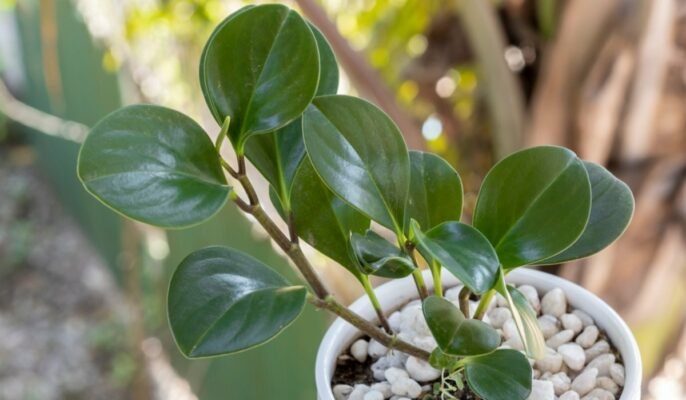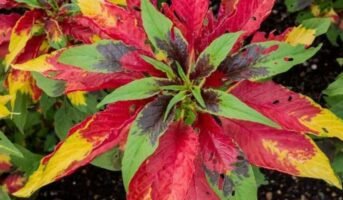Peperomia or baby rubber plants are a diverse group of tropical plants that belong to the genus Peperomia, native to regions such as Mexico, South America, and the Caribbean. These plants are known for their thick, fleshy leaves that can withstand drought and contribute to their overall hardiness. One of the great things about Peperomia plants is that they are not only low maintenance but also boast attractive foliage, making them a popular choice for those who may have struggled with flowering houseplants in the past. With over 1,000 species, the Peperomia genus offers a wide range of leaf shapes, colours, and textures, from large, heart-shaped leaves in red or green to tiny, textured leaves in grey or purple.
Source: Pinterest
See also: Rubber Tree: Facts, benefits, how to grow, and maintain
Peperomia: Quick facts
| Common Name | Baby rubber plant, pepper elder, radiator plant, shining bush plant, emerald ripper pepper |
| Botanical Name | Peperomia spp |
| Kingdom | Plantae |
| Clade | Tracheophytes |
| Family | Piperaceae |
| Height | 6–12 in. tall, 6–12 in. wide |
| Native | Central America, South America, and the Caribbean |
| Benefits | Ornamental Plant |
Peperomia: Physical description
Peperomia plants can grow up to 12 inches tall and wide, but some species can reach up to 2 feet tall. The leaves are usually thick and fleshy, varying in size, shape, and colour, from large heart-shaped leaves to small, round leaves. They also have delicate stems and small, insignificant flowers that grow in spikes.
Peperomia: How to grow?
The Peperomia plant is an ideal choice for those just starting with houseplants. They are low-maintenance plants that can tolerate some neglect and come in a wide range of colours and textures. Whether you are looking to add variety to your collection or create an interesting display in your home, Peperomia plants have something for everyone.
By cutting:
- Cut a stem from the mother plant, including at least an inch of its stem and a leaf.
- Place the stem cutting in a small container filled with potting soil, with the cut end facing downwards.
- Place the container in a brightly lit location with indirect light.
- Cover the container with plastic wrap to create a mini-greenhouse environment, helping to retain moisture.
- Water consistently to prevent the soil from drying out. Roots should form within a few weeks.
- Once the cutting has outgrown its original container, transplant it into a larger one.
By seed:
- Fill a container with the soilless seed starting mix.
- Add water and place the container in a warm, bright spot with indirect sun.
- Keep the soil consistently moist until the seeds germinate.
- Once the young seedlings have emerged, transplant them into a larger container and place the plant in a bright spot with indirect sun.
Peperomia: Maintenance tips
- Light: Peperomia plants thrive in medium to bright light to maintain their vibrant foliage colours. Direct sunlight should be avoided as it can burn the leaves.
- Soil: Peperomia plants are epiphytes, meaning they grow in the nooks of trees with roots in slightly decaying bark. To mimic these conditions, use a loose and acidic soil blend, such as an orchid potting mix or regular potting soil with added peat moss or vermiculite.
- Water: With succulent leaves, Peperomia plants don’t require frequent watering. Allow the soil to dry out between waterings and avoid over-saturating the soil, which can lead to root rot.
- Temperature and humidity: Peperomia plants can’t handle freezing temperatures. As tropical plants, they prefer a warm and humid environment, especially in the summer months. To increase humidity, place the plant on a tray of pebbles and water or invest in a small humidifier.
- Fertiliser: Peperomia plants grow slowly and can go their entire lives without supplemental fertiliser, getting what they need from the potting soil. If you do choose to fertilise, less is more.
Peperomia: Uses
Peperomia plants are popular houseplants due to their attractive foliage and low-maintenance requirements. They are often used in terrariums, and dish gardens, or grown on their own as accent plants. They can also be used in mixed containers and as ground covers in shady areas.
Peperomia: Toxicity
The plants are non-toxic to cats and dogs.
FAQs
What is the best light for Peperomia plants?
Peperomia plants prefer bright but indirect light, so they are ideal for east-facing windows or near windows covered with sheer curtains.
How often should I water my Peperomia plant?
Peperomia plants do not like to be overwatered, so wait until the soil is dry to the touch before watering. This will vary depending on factors such as the humidity and temperature in your home. So, monitor your plant regularly to determine its watering needs.
How can I prevent my Peperomia plant from getting too big?
Peperomia plants grow slowly, so they won't take over your space. To control their size, simply prune dead leaves and stems regularly.
What kind of fertiliser is best for Peperomia plants?
Use a balanced fertiliser every 2-3 weeks during the growing season. A liquid fertiliser or slow-release fertiliser pellets are both good options.
| Got any questions or point of view on our article? We would love to hear from you.
Write to our Editor-in-Chief Jhumur Ghosh at jhumur.ghosh1@housing.com |
Housing News Desk is the news desk of leading online real estate portal, Housing.com. Housing News Desk focuses on a variety of topics such as real estate laws, taxes, current news, property trends, home loans, rentals, décor, green homes, home improvement, etc. The main objective of the news desk, is to cover the real estate sector from the perspective of providing information that is useful to the end-user.
Facebook: https://www.facebook.com/housing.com/
Twitter: https://twitter.com/Housing
Email: editor@housing.com

